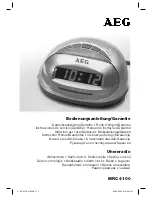
© MOBATIME
19 / 96
800337.22
8
External Time Sources
8.1 General
It is possible to connect the ETC to several kinds of time reference. This chapter gives a
short description of the time sources. The configuration of the corresponding
synchronisation mode will be described in chapter 10.
8.2
DCF – Radio Time Receiver
The connection of a DCF time signal receiver allows the synchronisation from the long
wave time signal emitter DCF-77 in Mainflingen (near Frankfurt a.M.), Germany.
The transmission of a time telegram spreads over one minute. After five successive
correctly received telegrams the ETC takes over the time information, that means that
the synchronisation can last up to 5 minutes at faultless reception.
At good reception the LED in the receiver (DCF 4500) must flash in second rhythm. The
signal quality will be increased each second of 1 up to the max. value of 100. For each
correctly received time telegram, the value of the telegram quality will be increased of 10
up to the max. value of 100.
Available DCF time signal receivers: DCF 4500
The connection of some time signal receivers is not polarity dependent. For further
information please consult the corresponding documentation for the receiver.
8.3
MSF – Radio Time Receiver
The connection of a MSF time signal receiver allows the synchronisation from the long
wave time signal emitter MSF-60 in Rugby, England.
Available MSF time signal receivers: MSF 4500
For more information see chapter 8.2.
8.4 GNSS
3000
The GNSS 3000 time signal receiver is sending a DCF time code with UTC time. Time
source has to be set to GPS 4500 (time zone 00 [UTC] is predefined, see Chapter 10.1
und 10.5).
The connection diagrams are illustrated in annexe G.
8.5
GPS / GNSS 4500
The GPS / GNSS 4500 time signal receiver is sending a DCF time code with UTC time.
Time source has to be set to GPS 4500 (time zone 00 [UTC] is predefined, see Chapter
10.1).
The connection diagrams are illustrated in annexe G.
8.6 Minute
Impulses
The opto-coupler interface (Art. No. 118922) allows the synchronisation with polarised
minute impulses of 24 V or 48 V. The setting of date and time must be made manually.
The seasonal time change-over will be executed automatically.
The opto-coupler interface has to be connected to the terminals DCF in +/-, see also
annexe A.
















































